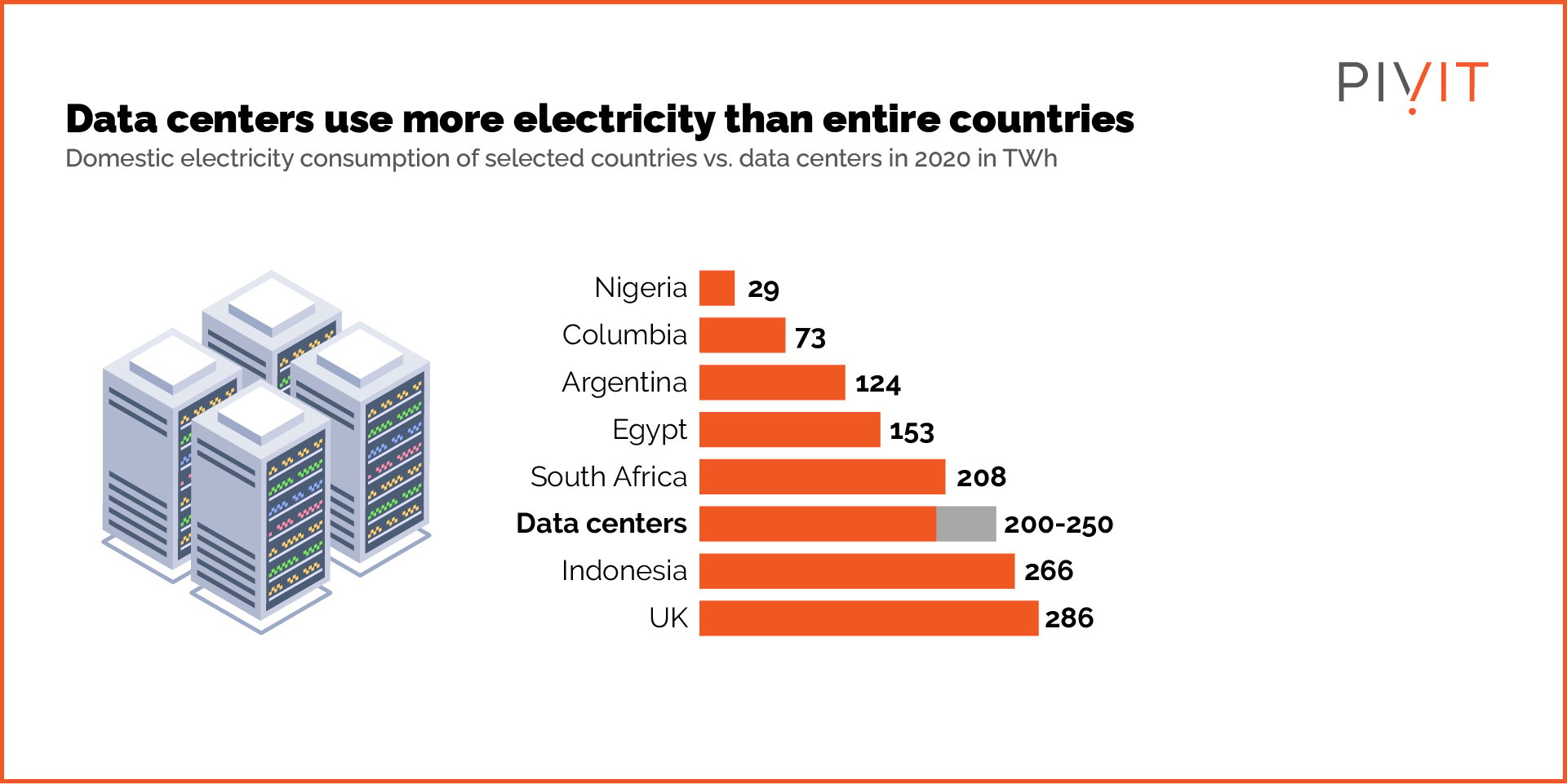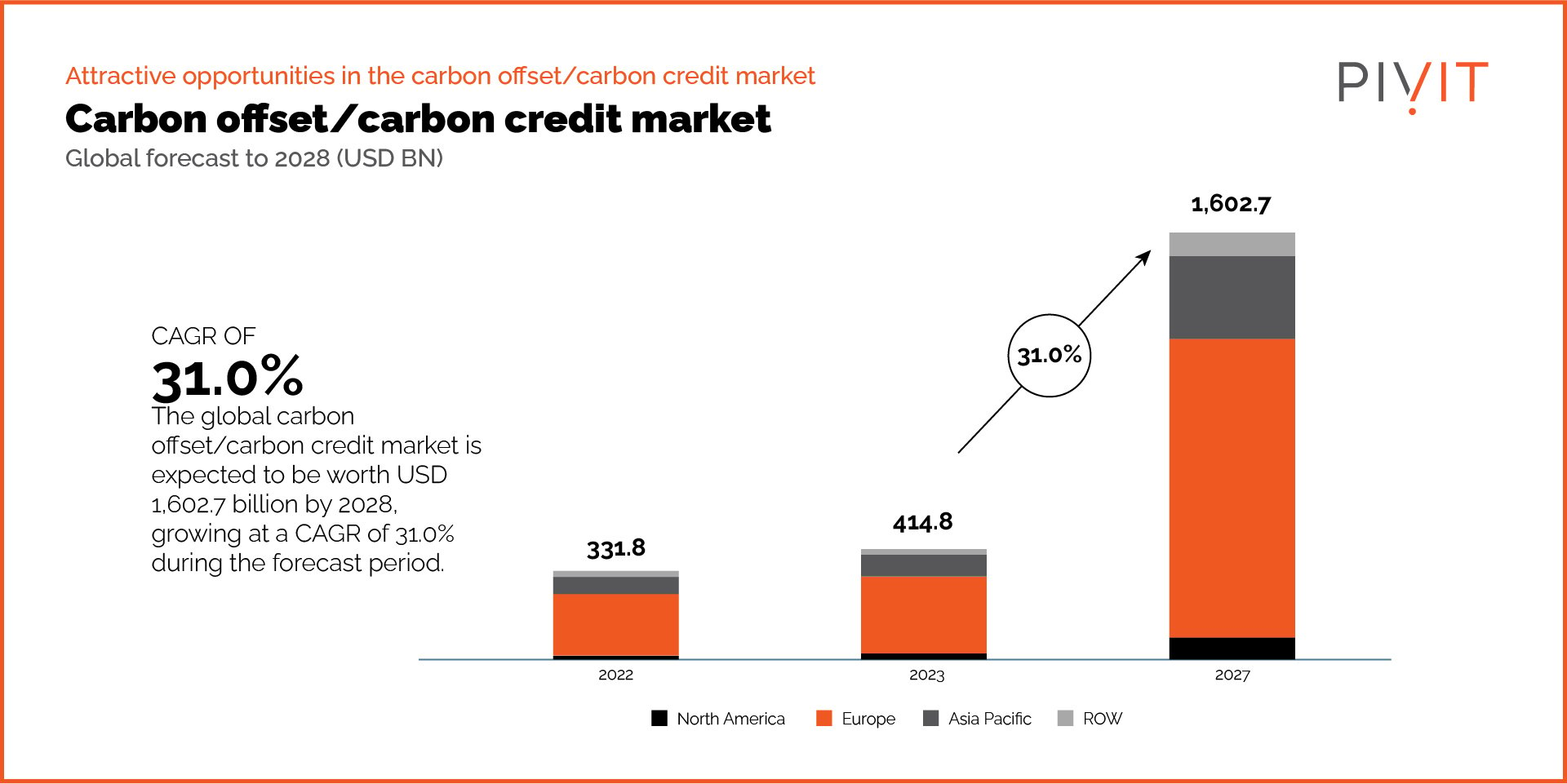How Can Data Centers Offset Emissions (And Should They?)
%20How%20Can%20Data%20Centers%20Offset%20Emissions%20(And%20Should%20They).png)
Data centers produced 330 Mt of carbon dioxide in 2020, according to the International Energy Agency. Collectively, this part of the IT industry is responsible for 2% of global emissions, mainly through the consumption of fossil-fuel-produced energy.

(Data source: Data center energy consumption)
One of the ways data centers and the corporations behind them can achieve the 2050 net-zero emissions goal is carbon offsetting. It’s a widespread practice in many industries that helps reduce the overall carbon footprint of a company without directly reducing operational emissions.
Of course, the most impactful way a data center can alter its environmental impact is by reducing its emissions. However, achieving net zero emissions for a structure entirely reliant on energy isn’t as black and white as expected. And that’s where carbon offsetting and credits may help.
This article explains the ins and outs of offsetting emissions from a data center and whether it’s a viable environmental strategy.
What Does Carbon Offset Mean?
A carbon offset is a compensation for greenhouse gas (GHG) emissions. It balances GHG emissions by removing equivalent carbon dioxide or other equivalent GHG emissions from the environment.
Carbon offsets are typically measured in tonnes of carbon dioxide equivalent (tCO2e). For example, if a company’s operations produce 100,000 tCO2e in a year, it can offset those emissions by completing or funding activities that remove an equivalent amount of GHG, like planting trees.
Carbon offsetting has cropped up a new industry comprising agencies offering carbon credits. Companies can offset emissions by purchasing carbon credits. These credits represent a certain amount of carbon dioxide that will be removed from the environment.

(Data source: Markets and Markets - carbon offset credit market)
In some countries, companies can purchase carbon credits to compensate for the emissions they produce.
Carbon credits have been controversial, as they’re often seen as a means for companies to produce more emissions. However, optimal and ethical use of carbon offsets can benefit the environment and help companies reduce their carbon footprint.
Why Should Data Centers Consider Carbon Offsets?
Enterprises with large data centers, such as cloud providers, are increasing efforts to tackle climate change. That’s good news. However, it’s impossible to become greener overnight, especially for enterprises with a global presence.
While the best way to reduce your carbon footprint is by directly reducing emissions, carbon offsets provide a way to accelerate your efforts or meet regulatory requirements.
Depending on the location of your data center, you may face caps on the amount of emissions you can produce. You can purchase carbon credits if your emissions exceed the cap.
Global temperature is rising pretty fast, resulting in weather extremes and calamities. Climate change also threatens data centers, as natural disasters can disrupt operations and impact uptime and availability.
So reducing or offsetting data center emissions isn’t just a need because of the warming planet but also for sustaining business.
Besides meeting environmental policy goals, carbon offsets also show commitment to reducing emissions.
Consumer sentiment has drastically changed over the years, with many paying attention to a company’s sustainability efforts. A McKinsey and NielsenIQ joint study revealed that 78% of U.S. consumers value a sustainable lifestyle. Therefore, products and services that are sustainable are likely to attain growth.
The same can be said about data centers that provide services, as more and more businesses may opt for vendors that take sustainability seriously. Simply put, offsetting carbon emissions can also be good for business.
Ways Data Centers Can Offset Emissions
Data centers with a significant carbon footprint can offset emissions by purchasing carbon credits with brokers or initiating projects that help remove GHG emissions.
Purchasing Carbon Credits
The easy way, of course, is to pay a broker for carbon credits. However, several carbon offset companies have been found to be scams lately.
A study on one of the biggest carbon standards in the world that issues carbon credits found that its claimed impact was far smaller than the actual emissions removed. Of the 94.4 million carbon credits sold, the actual emissions removed from the environment were equivalent to only 5.5 million credits.
Unfortunately, carbon offsetting has become one more way for companies to greenwash.
To offset data center emissions through purchased carbon credits, ensure that the broker or agency you opt for is independently verified. Take the time to vet the provider and analyze the true impact of the carbon credits they offer.
Actively engage with the broker and keep track of their efforts to materialize the carbon credits. This way, you can ensure that you’re not being scammed and that your investment in carbon credits is bringing about a realistic, measurable change.
Undertake Carbon Offsetting Activities
If you don’t want to purchase carbon credits, you can invest in projects that capture or reduce GHG emissions. Of course, such projects require strategy and oversight to ensure that the outcome lives up to the projections.
Carbon accounting is a pre-requisite to initiating offsets, whether through the purchase of credits or self-managed projects. You must calculate and analyze your data center’s emissions and create targets for offsets.
A Better Alternative: Reducing Carbon Emissions Directly
Although beneficial in some ways, carbon offsetting can’t solve the climate crisis. The overestimated impact of carbon credits and widespread abuse shows this strategy isn’t the most effective.
Data centers and IT companies can create a much stronger impact by reducing their emissions and embracing circular economy practices. Circular strategies, such as using refurbished equipment, implementing closed-loop systems for hardware recycling, and repurposing heat from serves, can significantly cut emissions while reducing resource consumption.
Unlike carbon offsets, reducing operational GHG emissions requires grassroots-level changes. And truth be told, it can be a big undertaking. However, by reducing their carbon footprint, data centers can progress toward a carbon-neutral or, even better, net-zero future.
Here are three practical ways data centers can drastically reduce their emissions and help in salvaging the planet:
Switch to Renewable Energy
The majority of the emissions produced by data centers are through energy consumption. As many facilities use energy from suppliers that burn fossil fuels, they become responsible for the associated emissions.
Switching to clean energy is the most effective method for reducing carbon emissions. Enterprises with on-premise data centers can go fully green by switching to renewable resources like wind or solar.
Some of the largest cloud providers with massive data centers are already investing heavily in renewable energy. Over 40 GW of energy used by data centers in the U.S. comes from renewable sources as of 2022.
Natural/Liquid Cooling Solutions
Another way data centers are reducing their energy consumption is by opting for natural cooling. Maintaining an optimal temperature desirable for servers is difficult, and often data centers are way cooler than they need to be. Utilizing natural cooling where feasible can reduce energy reliance.
Liquid cooling is also a great alternative to air conditioning systems, as it’s much more energy-efficient. It’s still in early adoption as companies explore innovative solutions tailor-made to their needs. However, it’s a worthy investment, given the long-term emission reductions it can create.
Energy-Efficient Equipment
Lastly, investing in servers, storage, and network equipment designed to use less energy can also make a big difference. As refresh cycles approach for your data center equipment, replacing them with the latest energy-efficient devices can slowly but surely reduce the carbon footprint.
Dell’s PowerEdge and HPE’s ProLiant are examples of energy-saving servers on the market.
Go Green!
Create strong policies for reducing and offsetting data center emissions and align them with global benchmarks for energy efficiency. As data demands grow, and so does your infrastructure, keep your carbon footprint in check.
When it’s time to refresh or add new equipment, procure energy-efficient devices with the help of PivIT. Our experts can source the hardware that delivers your desired performance without increasing emissions.

